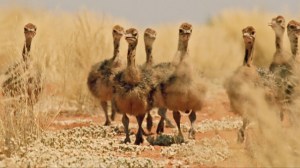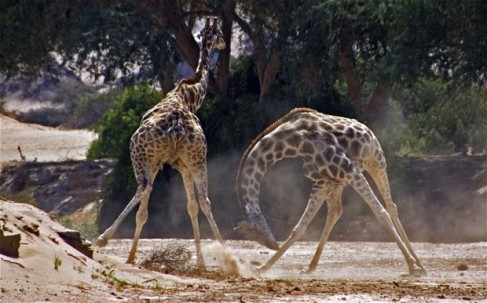Episode 1 of David Attenborough’s latest wildlife documentary. This 6 part series was filmed over four years in beautiful detail, with some incredible close ups and intriguing slow motion shots.
In the South-West of Africa, Attenborough journeys around Namibia. Kalahari means ‘Land of Great Thirst’ and it is indeed a tough environment to survive in. Temperatures drop below zero at night and rise above 40 degrees Celsius during the day.
We see the drongo – a bird that lives alongside meerkats in the summer – warning them of danger. In the winter, the hardest months, the drongo uses the trust it has built up to it’s advantage. It will cry false alarms then, when the meerkats scamper undercover, steal the food they have been unearthing. It has even learnt to mimic the meerkat sentry itself.
We follow a family of Ostriches, the babies just days old as they cross the Etosha Salt Pan in search of water. Adult ostriches have no need to drink, but the babies will die without. The father shades the babies from the hot sun as the journey across the vast open Pan. Eventually they find water but elephants, zebras, wildebeest and giraffes make it far from easy to get at it.
Clouds of red-billed quelea have a talent for finding the rain, over a billion of them live in the Kalahari. Their young are the prey for armoured ground crickets – large, meat-eaters that scale the trees and climb into the queleas’ nests. When the adults return the crickets spray their own blood into the birds eyes, but undeterred, the quelea knock them from the trees. The still-live, bleeding crickets on the ground attract others, revealing their cannabalistic tendencies.
Deep inside Dragon’s Breath Cave, 60 metres below the desert, lies the World’s largest underground lake. Over 100 metres deep it is home to golden catfish, the rarest and most isolated fish in the World. Completely blind, they live in perpetual darkness, eating whatever debris they can find on the top of the water.
On the sandy Hoanib river an elderly, male giraffe is protecting a female. He must fight for her, and his prime territory that he has held for over a decade from a young male. Using his long neck, he whip his head into the opponent’s body. At one point, a blow to his rump knocks him to his knees, but he waits, and as the young giraffe swings at his head he ducks, then aims a powerful blow at their legs. The young giraffe is knocked out for over three minutes, so long the camera crew believed he had died. The damage done to one another is surprisingly severe, bleeding holes and gaping slits cover both of them.
The highlight of the programme had to be the black rhinoceroses, this section was filmed at night, but the quality of the cameras is such that the images are as clear as day. For the first time, the rhinos are seen gathering, near a large watering hole. What makes it unusual is they do not come to drink, but to socialise, they greet each other individually, sniffing tentatively. Hidden microphones capture a surprising range of grunts, puffs and squeaks as they communicate with one another. A mother and her calf meet another female, the baby is particularly curious and the mother uncharacteristically relaxed. A young female selects a new partner, she chooses a young male whose tusk is comically adorned with Kudu horns, over a much larger male who had originally taken her fancy. However the meeting does not go to plan, when the male turns out to be rather inexperienced, the female lies down and pretends to fall asleep in order to get rid of him.
The episode concludes with a ten minute “Eye to Eye” section, which goes behind the scenes for two parts of the shooting. This time it focuses on the filming of the giraffe fight and the night-time rhino gathering.
Next episode – ‘Savannah’: Attenborough will go to East Africa travelling the mountains, swamps and vast savannahs. Each episode is 60 minutes long and is on Wednesdays at 9pm on BBC1. The episodes will all available on BBC iPlayer.

